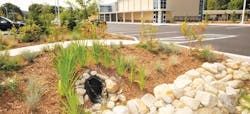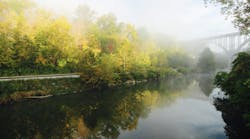About the author: Kent Schwendy, P.E., LEED AP, CNU-A, is senior vice president for Fuss & O’Neill Inc. Schwendy can be reached at [email protected] or 860.646.2469.
Many U.S. communities are in desperate need of storm water infrastructure replacements or repairs. What these communities are discovering is just how arduous the replacement and repair process can be. There are countless financial constraints as overall infrastructure costs can be expensive; there likewise is pressure to implement solutions that not only improve public health, but also are environmentally friendly.
Fortunately, many U.S. communities have learned that including green infrastructure in storm water projects can result in long-term financial savings, reduce energy usage, and provide aesthetic and social benefits. This article will detail the cost-effectiveness—value in terms of relatively low costs for the benefits—of storm water projects that implement green infrastructure, and also describe the many other benefits green infrastructure can bring.
Direct Cost Comparisons
The most easy-to-understand assessment of green infrastructure cost-effectiveness relies on direct cost comparisons with grey infrastructure (often referred to as such because grey infrastructure typically relies on heavily engineered and structural solutions). For example, the city of Portland, Ore., integrated green and grey approaches to storm water management in its combined sewer overflow (CSO) abatement program. Using the marginal cost per gallon removed from the CSO system as a metric, an analysis of green and grey infrastructure options showed that the former—which involved downspout disconnections, curb extensions that included vegetated swales and parking lot infiltration—was among the most cost-effective.
Also, green infrastructure cost savings can increase when considering overall project costs beyond the direct storm water management structures. A green street project in Seattle required less pavement, reducing costs associated with pavement by almost 50%. Meanwhile, when condominium developments use porous asphalt and other green infrastructure elements, the overall construction costs turn out to be less than the conventional approach, particularly in the areas of drainage infrastructure, erosion control and curbing.
Cost-Effective Approaches
Many storm water projects have proven that green infrastructure can be a cost-effective approach to rebuilding municipal rights-of-way. This has been accomplished by carrying out a number of improvements: replacing portions of aging public streets; bettering amenities for vehicles and pedestrians; and incorporating drainage features to improve the quality and reduce the quantity of storm water.
Also, when compared with conventional approaches, green infrastructure can be more cost-effective over time. Many municipalities are implementing “green alley” programs, which introduce permeable pavements, downspout disconnection, rain barrels and tree planting to urban environments. These programs have demonstrated that when compared with conventional methods, green infrastructure can be three to six times more effective in managing storm water per $1,000 invested.
It should be noted that the cost estimates vary depending on the type of technology employed. Permeable pavement in green alleys can cost $0.10 to $6 per sq ft with a service life of seven to 35 years (depending on the selected material). When these costs are offset by the avoided cost of employing storm water and local flooding capture and treatment programs, the benefits of green streets or alleys solutions outweigh upfront costs.
Reducing Energy Use
Storm water projects that feature green infrastructure practices also can help municipalities reduce energy consumption and spending. For example, infiltrating storm water to recharge groundwater supplies can reduce the energy required to transport water from distant sources. Water harvesting and reuse (including practices such as rain barrels and cisterns) also can reduce energy usage by saving on the need for highly treated drinking water for outdoor and other non-potable uses. Similarly, water used in industrial processes, landscaping and toilets can be replaced by harvested rainwater.
Another common green infrastructure practice that can reduce runoff and cut energy costs is the green roof. In addition to keeping polluted runoff out of local waterways, roofs also can increase building energy efficiency (when compared with traditional roofing techniques). The vegetation on green roofs lowers absorption of solar radiation and thermal conductance. This substantially reduces annual energy consumption for interior heating and cooling.
Finally, there is the practice of planting trees. These can lower surface and air temperatures through shading and evapotranspiration. Shaded surfaces often are 20°F to 40°F cooler than those that are non-shaded, which reduces electricity demand for cooling in summer. It is estimated that Washington, D.C.’s urban forest, parks and street trees (which cover 28.6% of the district) reduce building energy consumption costs by $2.65 million per year.
Maintenance Partnerships
Because green infrastructure uses natural processes rather than built systems, it will increase in resilience and function as vegetation matures and adapts to local resource cycles. Of course, it will require periodic maintenance for high-level functionality. Nonetheless, green infrastructure does have its advantages over grey infrastructure in this area because the latter requires increased operations and maintenance as equipment and materials wear down. This means grey infrastructure can be significantly more expensive in the long run.
Utilizing green infrastructure requires a change not just in storm water systems, but also in the approach to the operations and maintenance of these systems. This means that in order to keep green infrastructure working, storm water managers will need to implement maintenance programs that involve regular, less costly approaches. This can mean forging maintenance partnerships that help promote green infrastructure’s emphasis on sustainability and aesthetics. Surveys have shown that residents of communities often are willing to volunteer to help maintain green infrastructure vegetation.
A Valuable & Popular Solution
At a time when cost-effective and ecologically conscious solutions are needed to replace or repair aging storm water systems, green infrastructure is proving to be a valuable and increasingly popular solution. U.S. towns and cities can make an effort through creative budgeting and partnerships to join the countless other communities that already have implemented green infrastructure approaches in their storm water projects.
Download: Here


